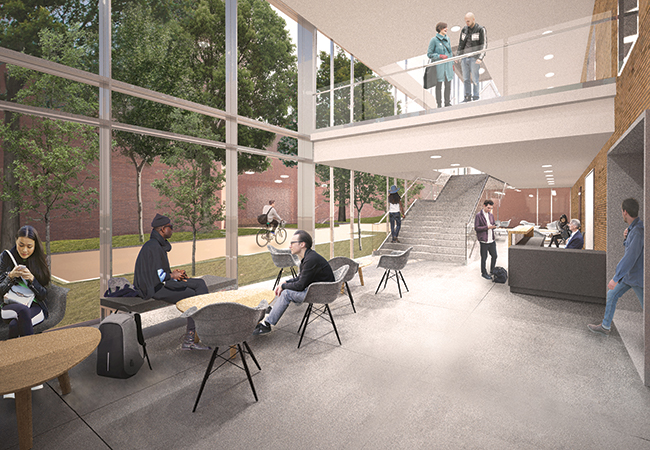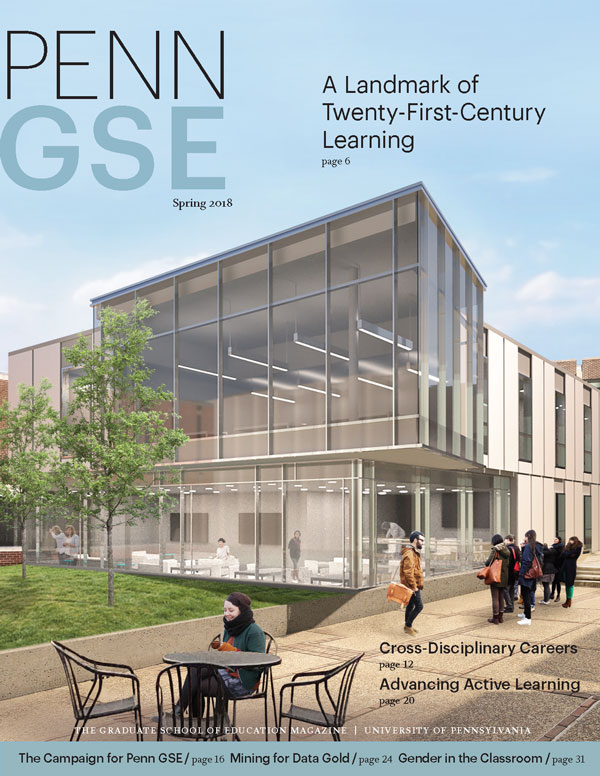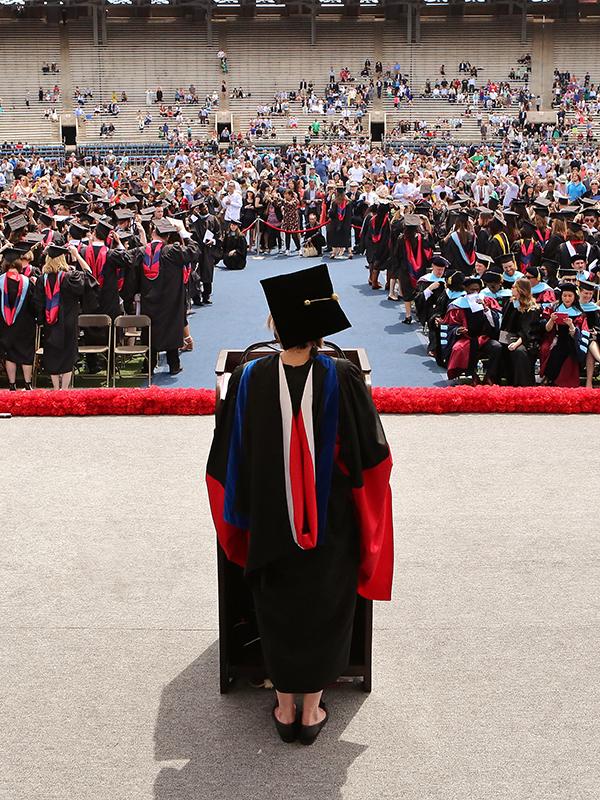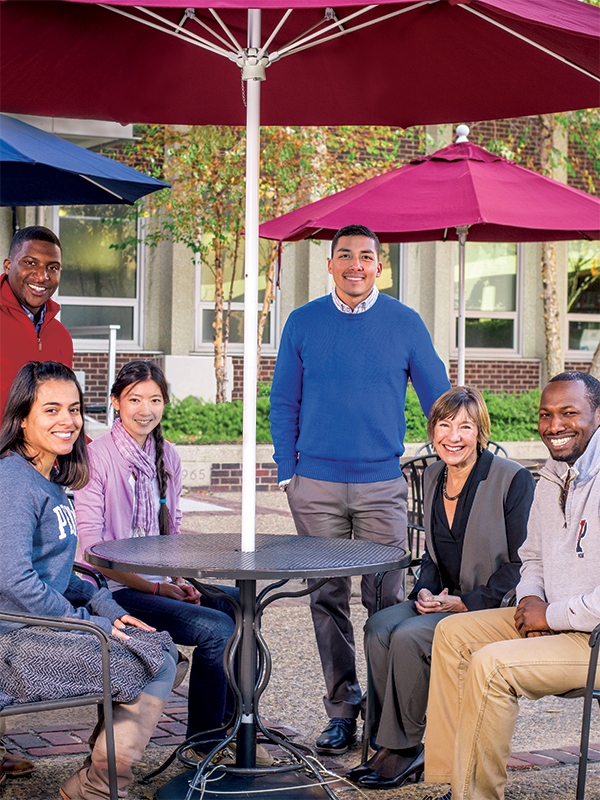A Landmark of Twenty-First Century Learning: Penn GSE Plans State-of-the-Art Home for Education on Campus

by Juliana Rosati
“This is a tremendous opportunity for Penn GSE to design educational spaces from the ground up, based on cutting-edge knowledge of how to support active learning.”
What does learning look like? In recent years, education has expanded beyond the traditional image of an instructor who imparts knowledge to an audience of learners. Innovative practices across K–12 and higher education ask students to spend class time brainstorming problems in the world around them, developing possible solutions, conducting research, and learning by creating—through computer programming, 3D printing, crafting, and more.
This shift to active and hands-on forms of learning requires state-of-the-art facilities. As an international leader in education research and practice, Penn GSE is embarking upon a building expansion to keep the School at the forefront of a new era in education.
“This is a tremendous opportunity for Penn GSE to design educational spaces from the ground up, based upon cutting-edge knowledge of how to support active learning,” says Dean Pam Grossman.
By strategically expanding the School’s central building at 3700 Walnut Street, merging it with nearby Stiteler Hall, and adding a two-story addition that will include a new center for innovation, the project will give Penn GSE nearly 25,000 additional square feet of flexible and technologically advanced learning space right in the heart of campus.

The project will also allow the School to house the majority of its programs, students, faculty, and staff on campus in one location, consolidating them from a current total of five sites on and off campus and capitalizing on the scope that the School represents today. Encompassing teaching, counseling, leadership, policy, language diversity, learning technology, entrepreneurship, and more, the work of Penn GSE touches every aspect of education.
“The enhanced facility will create an interdisciplinary hub for educators,” says Dean Grossman. “Future early childhood and K–12 educators, researchers, policymakers, entrepreneurs, chief learning officers, and others will learn side by side.”
With an internationally regarded faculty who develop and promote innovative practices in education locally, nationally, and globally, the School is well equipped with the expertise to create a landmark of twenty-first-century learning.
A Model of Twenty-First-Century Learning Spaces and Technologies
Not since the 3700 Walnut Street building was completed half a century ago has Penn GSE constructed a new facility. Founded as a small undergraduate school in 1914, Penn GSE grew during its first fifty years into a robust graduate school that required a new, dedicated home. The 3700 Walnut Street building, finished in 1965, was remodeled in 2001. Today it houses only a fraction of Penn GSE’s people and programs, with distinctly twentieth-century classrooms. Given what research reveals about environments for active learning, new approaches to design are essential.

“Buildings have to become more flexible. They have to allow instructors to reconfigure spaces for the learners who are in them,” explains Penn GSE Research Assistant Professor Sarah Schneider Kavanagh. “We know from research that learning happens through activity—speaking with classmates, moving through space, and making things.”
Driven by research on the value of collaboration and interaction in learning, the concept of a traditional classroom with rows of desks has given way in recent years to the broader notion of learning spaces that can be configured in multiple ways. These spaces allow teachers to customize the educational setting to a range of activities, from collaborative to individual work. In addition, an overarching shift away from lecture-format instruction to project-based learning has made students more active participants during class, an approach that makes flexible spaces and technological access essential.
Penn GSE faculty look forward to a collaborative design process that will draw upon their multiple perspectives. Those in the School’s teacher education programs envision the building as integral to producing the teachers of the future. “We want to prepare teachers who are ready to transform schools,” says Penn GSE Professor Janine Remillard, who is leading an initiative to re-envision the School’s teacher education programs so that they will develop, test, and adapt new teaching and learning approaches on an ongoing basis. (See page 5 to learn more.) “We want our students to understand what can exist in a state-of-the-art learning space,” she says.
Movable walls and seating, multimedia capabilities, touch-screen technology, and optimized sound and lighting will give Penn GSE’s enhanced facility the functionality to simulate a visionary K–12 classroom. This will allow teacher education students to practice the use of an advanced learning space, perhaps by hosting afterschool programs for students in The School District of Philadelphia. “Excellent teachers use their space in complex ways,” says Penn GSE Assistant Professor Abby Reisman, whose research focuses on helping social studies teachers facilitate discussion of historical texts. “The students understand the learning habits that are built into that space because the teacher does a lot of work to establish them.”
The benefits of the facility will extend to the entire Penn GSE community as faculty in all programs utilize the new capabilities and features in their instruction. “Penn GSE in general has been way ahead of the curve for a long time in practicing very active pedagogies, and now more than ever, there is demand across higher education for flexible space,” says Penn GSE Professor Matthew Hartley, associate dean for academic affairs, whose research has advanced higher education internationally in Kazakhstan, India, and other countries. Rather than simply delivering information to an audience of students, faculty today are more likely to lead a class through a combination of small-group work and discussion. Dr. Hartley, a member of Penn GSE’s Higher Education division, sees interaction as key. “There are tremendous funds of knowledge in the classroom,” he says. “Many of our students have deep experience as leaders, from the entry level to deans and presidents. Instructional practices that allow us to tap the expertise in the classroom provide richer learning.”

Beyond the field of education alone, laboratories to fuel innovation are burgeoning. “If you look at places where really great innovation is happening, like Google, you’ll see people sitting in open spaces around tables discussing ideas,” says Penn GSE Professor Susan Yoon, whose research explores how technology such as mobile devices and computer simulations can enhance science education. “They’re looking at shared screens or interactive whiteboards. We call that ‘hive mentality’ or ‘swarm creativity.’ It’s both motivating and really productive.” To support such approaches and Penn GSE’s longtime commitment to innovation, the planned two-story addition to Stiteler Hall will include an innovation laboratory that will house Catalyst, the School’s new center for academic innovation. “We will use the space to facilitate creativity, collaboration, and productivity by students, faculty, alumni, entrepreneurs, visiting thought leaders, and community members who are striving to address complex problems in education through new solutions and ventures,” says Executive Director Michael Golden, GRD’07.
Within the laboratory, a “makerspace” will offer materials and equipment for creative work. Such facilities have grown out of the Maker movement, which embraces a “do-it-yourself” approach to technology and traditional crafts. The movement coincides with educational approaches such as project-based learning and design thinking, in which students learn through the process of conducting a project or creating an object. “Teachers are transforming their classrooms into makerspaces,” says Penn GSE’s Yasmin B. Kafai, Lori and Michael Milken President’s Distinguished Professor. Dr. Kafai, for example, has developed curricula that ask high school students to create with electronics, textiles, and synthetic biology.
In this multifaceted environment, Penn GSE students across the School will experience a state-of-the-art educational environment as they prepare for careers in which they will advocate for and design spaces to meet learners’ needs.
An Interdisciplinary Home for Education
Whether she is walking to and from her office in the 3700 Walnut Street building during the workday or attending late-night meetings and campus events, Dean Grossman sees Penn GSE students hard at work. “I am so struck by how well used this building is,” says Dr. Grossman. Areas such as the first-floor lounge and fourth-floor doctoral study space fill quickly with students seeking to work individually or collaboratively, depending upon their class assignments and research pursuits. Dr. Remillard, whose office neighbors the fourth-floor area, agrees. “Research is, for the most part, a collaborative endeavor,” she says. “We need more flexible space, like we have on this floor, with more opportunities for students to work with one another.”
Due to the level of demand and the range of needs, the building project will create a new entrance to 3700 Walnut Street leading to a four-story glass pavilion for students. This addition will offer different areas designated for individual and group work. Semiprivate group space will be an asset, according to Penn GSE Student Government President Laronnda Thompson, a student in the Interdisciplinary Studies in Human Development Ph.D. program. “We tend to form writing teams in both the master’s and doctoral programs. You need to be able to collaborate to brainstorm for papers or workshop your classmates’ essays,” she says. “Students in certification programs need to discuss their fieldwork experiences—what’s working and what isn’t when they implement lesson plans in K–12 schools. And student government needs to meet with students to plan programming and address issues of student life.”
With expanded space for both class time and study, the enhanced facility will advance best practices in education and achieve another broad aim—that of consolidating all of the School’s degree programs from five on- and off-campus locations into one campus hub.

“We will be thrilled to create a home for all of our degree programs and students and to leverage that proximity to establish new synergies, opportunities, and networks,” says Grossman. The building will create a dynamic interdisciplinary setting for Penn GSE’s nearly 1,300 students. Future early childhood and K–12 educators, higher education leaders, researchers, policymakers, entrepreneurs, chief learning officers, and others will learn together as they prepare to transform lives through education.
The opportunity for regular interaction across programs will give students a dramatically enhanced experience of academic and professional community. Hartley views such connections as particularly pertinent to future educators, who must address challenges such as underfunded schools, varying approaches to reform, linguistic and national boundaries, and the link between educational access and economic opportunity. “Most of the issues that we’re dealing with in education are extremely complex,” he says. “We need to think together about how to enact positive change in a whole host of different contexts.”
The building will foster a community that unites master’s and doctoral students in traditional programs with those in Penn GSE’s executive-format programs, which meet for intensive weekend sessions to accommodate the schedules of working professionals. Representing nearly 40 percent of the School’s student body, executive students often attend class in spaces other than Penn GSE’s main building, not fully experiencing the campus community. The success of such programs is a significant source of the School’s growth and a result of its leadership in innovation.

“Executive students want to be more a part of the hustle and bustle on campus,” says Penn GSE Senior Fellow Michael C. Johanek, who directs the Mid-Career Doctoral Program in Educational Leadership and chairs the School’s committee on executive-format programs. “They welcome opportunities to connect with Penn GSE students in other programs. They see that as critical to their work, particularly in their leadership roles.” Another executive program director, Penn GSE Senior Fellow Jenny Zapf, reports similar observations of the Education Entrepreneurship master’s program. “Our edu-preneurs are eager to find community partners, beta sites, cofounders, and others to help understand, test, and scale new education models.” Penn GSE Senior Fellow Annie McKee, director of the Chief Learning Officer (PennCLO) and Medical Education executive programs, agrees on the importance of cross-program connections. “Housed together, we will have the chance to get to know each other better and to learn so much about one another’s diverse backgrounds and experiences,” she says.
The centralized presence will also support the School’s national model of partnership through its work with The School District of Philadelphia. That work includes field placements of Penn GSE students in teaching and counseling; professional development for District teachers; workshops in subjects like science, coding, and filmmaking for District students; research by Penn GSE faculty to improve education; alumni working as teachers and leaders; and more. “We are working locally in lots of ways to help solve problems in education,” says Yoon, who pilots her science curricula in the District and envisions working with District students in the enhanced building. “With a central location and more space, we can serve as the glue to develop robust, healthy, interactive, innovative communities,” she says.
Of course, all of Penn GSE’s work contributes to and engages with the world-class research university environment of Penn. Grossman notes that in the context of the University’s local, national, and global mission, the promise of one integrated home for education holds an added significance. “Education is at the core of the University’s mission,” she says. “To have a school of education at the center of campus with a strong, multifaceted presence sends the message that we value education at all levels, from preschool through graduate school. I think that is an incredibly powerful statement to make.”
The building project is part of Penn GSE’s Extraordinary Impact Campaign. This article originally appeared in the Spring 2018 issue of The Penn GSE Magazine.



